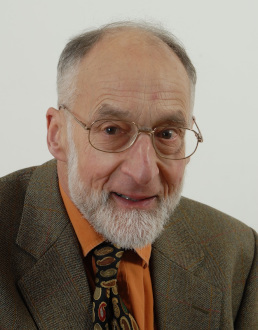Robin Milner facts for kids
Quick facts for kids
Robin Milner
|
|
|---|---|
 |
|
| Born |
Arthur John Robin Gorell Milner
13 January 1934 |
| Died | 20 March 2010 (aged 76) |
| Known for |
|
| Awards |
|
| Scientific career | |
| Fields | Computer science |
| Institutions |
|
| Doctoral advisor | None, as Milner never did a PhD |
| Doctoral students | Mads Tofte (1988) Faron Moller Chris Tofts Davide Sangiorgi (1993) |
Robin Milner (born Arthur John Robin Gorell Milner; January 13, 1934 – March 20, 2010) was a famous British computer scientist. He won the Turing Award, which is like the Nobel Prize for computer science. Milner made big contributions to how computers work and how they can be programmed.
He helped create important tools and ideas. These include a special computer language called ML and ways to understand how computer programs talk to each other.
Contents
Life and Education
Robin Milner was born in Yealmpton, a small town near Plymouth, England. This was on January 13, 1934. He came from a family where many people worked in the military.
When he was 13, in 1947, Robin won a special scholarship. This allowed him to attend Eton College, a very old and famous school. In 1952, he won the highest math prize at Eton, called the Tomline Prize.
After school, Robin served in the Royal Engineers. This is a part of the British army. He became a Second Lieutenant.
University Studies and Early Jobs
Later, Robin went to King's College, Cambridge. He finished his studies there in 1957.
His first jobs were not in computer science. He worked as a schoolteacher for a while. Then, he became a programmer at a company called Ferranti.
In 1973, Robin started working at the University of Edinburgh. Here, he helped start a special lab. It was called the Laboratory for Foundations of Computer Science (LFCS).
Later, in 1995, he moved back to Cambridge. He became the head of the Computer Laboratory there. He eventually stepped down from this role but continued to work at the lab.
From 2009, Robin was a special research fellow. He also held a part-time job as a professor at the University of Edinburgh.
Robin Milner passed away on March 20, 2010. He died from a heart attack in Cambridge.
Milner's Big Ideas in Computer Science
Robin Milner is known for three main things he gave to computer science. These ideas helped shape how computers are designed and how we think about them.
LCF and ML Language
First, he created something called Logic for Computable Functions (LCF). This was one of the first tools that could help computers prove things automatically. Imagine a computer checking if a math problem's solution is correct all by itself!
The language he made for LCF was called ML. This was a very important computer language. It was the first language to have "polymorphic type inference." This means the computer could figure out what kind of data you were using without you having to tell it every time. ML also had "type-safe exception handling." This helped programs deal with errors in a safer way.
Understanding Concurrent Systems
Second, Milner developed a way to understand "concurrent systems." These are computer programs or parts of programs that run at the same time. Think of many apps open on your phone, all doing different things.
He created a special framework called the calculus of communicating systems (CCS). This was a way to describe how these different parts of a program talk to each other. Later, he made an even more advanced version called the π-calculus. These tools help computer scientists design and check complex systems.
Bigraphs and Type Systems
When he passed away, Robin was working on a new idea called bigraphs. This was a way to describe how things move and interact in complex computer systems. It was meant to combine his earlier ideas like CCS and the π-calculus.
He also helped rediscover an important concept called the Hindley–Milner type system. This system helps make sure computer programs are written correctly and avoid certain kinds of errors.
Awards and Recognition
Robin Milner received many honors for his work.
- In 1988, he became a Fellow of the Royal Society. This is a very old and respected group of scientists. He also became a Distinguished Fellow of the British Computer Society.
- In 1991, he won the ACM Turing Award. This is one of the highest awards in computer science.
- In 1994, he was made a Fellow of the ACM.
- In 2004, the Royal Society of Edinburgh gave him a Royal Medal. This was for his work that helped people all over the world.
- In 2008, he was chosen as a Foreign Associate of the National Academy of Engineering. This was for his "fundamental contributions to computer science." These included LCF, ML, CCS, and the π-calculus.
The Royal Society even named an award after him, called the Milner Award.
Selected Publications
Robin Milner wrote many important books and papers. Here are some of them:
- A Calculus of Communicating Systems, 1980.
- Communication and Concurrency, 1989.
- The Definition of Standard ML, with Mads Tofte and Robert Harper, 1990.
- Commentary on Standard ML, with Mads Tofte, 1991.
- The Definition of Standard ML (Revised), with Mads Tofte, Robert Harper, and David MacQueen, 1997.
- Communicating and Mobile Systems: the π-Calculus, 1999.
- The Space and Motion of Communicating Agents, 2009.
See also
 In Spanish: Robin Milner para niños
In Spanish: Robin Milner para niños

